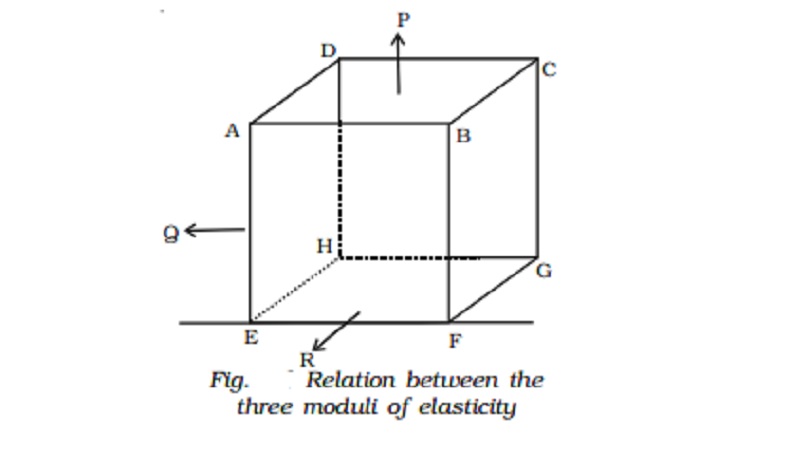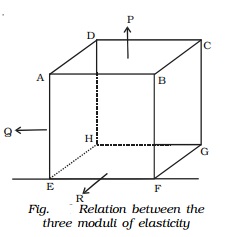Chapter: 11th 12th std standard Class Physics sciense Higher secondary school College Notes
Relation between the three moduli of elasticity

Relation between the three moduli of elasticity
Suppose three stresses P, Q and
R act perpendicular to the three facesABCD, ADHE and ABFE of a cube of unit
volume (Fig.). Each of these stresses will produce an extension in its own
direction and a compression along the other two perpendicular directions. If λ
is the extension per unit stress, then the elongation along the direction of P
will be λP. If µ is the contraction per unit stress, then the contraction along
the direction of P due to the other two stresses will be µQ and µR.

The net change in dimension
along the direction of P due to all the stresses is e = λP - µQ - µR.
Similarly the net change in
dimension along the direction of Q is f = λQ - µP - µR and the net change in
dimension along the direction of R is g = λR - µP - µQ.
Case (i)
If only P acts and Q = R = 0
then it is a case of longitudinal stress.
∴ Linear strain = e = λP
Young's modulus q =linear
stress /linear strain = P / λP
q= 1/λ
or
λ = 1/q
……………....(1)
Case (ii)
If R = O and P = - Q, then
the change in dimension along P is e = λP - µ (-P)
(i.e) e = (λ + µ) P
Angle of shear θ = 2e* = 2 (λ
+ µ) P
Rigidity modulus
n = P/θ
= P/ 2(λ+ µ)P
……………..(2)
Case (iii)
If P = Q = R, the increase in
volume is = e + f + g
= 3 e = 3 (λ − 2µ) P (since e
= f = g)
∴ Bulk strain = 3(λ−2µ) P
Bulk modulus k = P / 3(λ -
2µ)P
Or (λ − 2µ)= 1/3k ……………(3)
From (2), 2(λ + µ) = 1/n
2λ + 2µ = 1/n
From (3), (λ − 2µ) = 1/3k
Adding (4) and (5)
3λ = 1/n + 1/3k
λ = 1/3n + 1/9k
∴ From (1),
1/q = 1/3n + 1/9k
9/q = 3/n + 1/k
This is the relation between
the three moduli of elasticity.
Related Topics